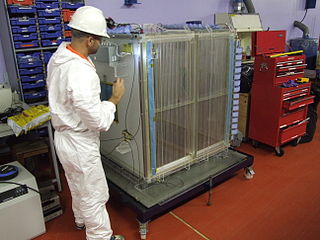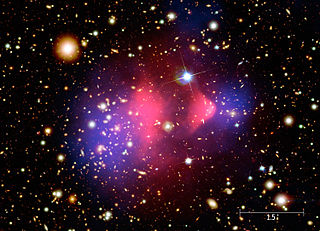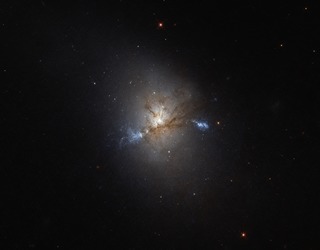
Dark matter is a form of matter thought to account for approximately 85% of the matter in the universe and about a quarter of its total mass–energy density or about 2.241×10−27 kg/m3. Its presence is implied in a variety of astrophysical observations, including gravitational effects that cannot be explained by accepted theories of gravity unless more matter is present than can be seen. For this reason, most experts think that dark matter is abundant in the universe and that it has had a strong influence on its structure and evolution. Dark matter is called dark because it does not appear to interact with the electromagnetic field, which means it does not absorb, reflect or emit electromagnetic radiation, and is therefore difficult to detect.

The study of galaxy formation and evolution is concerned with the processes that formed a heterogeneous universe from a homogeneous beginning, the formation of the first galaxies, the way galaxies change over time, and the processes that have generated the variety of structures observed in nearby galaxies. Galaxy formation is hypothesized to occur from structure formation theories, as a result of tiny quantum fluctuations in the aftermath of the Big Bang. The simplest model in general agreement with observed phenomena is the Lambda-CDM model—that is, that clustering and merging allows galaxies to accumulate mass, determining both their shape and structure.

A galaxy is a gravitationally bound system of stars, stellar remnants, interstellar gas, dust, and dark matter. The word galaxy is derived from the Greek galaxias (γαλαξίας), literally "milky", a reference to the Milky Way. Galaxies range in size from dwarfs with just a few hundred million stars to giants with one hundred trillion stars, each orbiting its galaxy's center of mass.
Weakly interacting massive particles (WIMPs) are hypothetical particles that are one of the proposed candidates for dark matter. There exists no clear definition of a WIMP, but broadly, a WIMP is a new elementary particle which interacts via gravity and any other force, potentially not part of the Standard Model itself, which is as weak as or weaker than the weak nuclear force, but also non-vanishing in its strength. Many WIMP candidates are expected to have been produced thermally in the early Universe, similarly to the particles of the Standard Model according to Big Bang cosmology, and usually will constitute cold dark matter. Obtaining the correct abundance of dark matter today via thermal production requires a self-annihilation cross section of , which is roughly what is expected for a new particle in the 100 GeV mass range that interacts via the electroweak force. Because supersymmetric extensions of the Standard Model of particle physics readily predict a new particle with these properties, this apparent coincidence is known as the "WIMP miracle", and a stable supersymmetric partner has long been a prime WIMP candidate. However, recent null results from direct-detection experiments along with the failure to produce evidence of supersymmetry in the Large Hadron Collider (LHC) experiment has cast doubt on the simplest WIMP hypothesis. Experimental efforts to detect WIMPs include the search for products of WIMP annihilation, including gamma rays, neutrinos and cosmic rays in nearby galaxies and galaxy clusters; direct detection experiments designed to measure the collision of WIMPs with nuclei in the laboratory, as well as attempts to directly produce WIMPs in colliders, such as the LHC.

A galaxy cluster, or cluster of galaxies, is a structure that consists of anywhere from hundreds to thousands of galaxies that are bound together by gravity with typical masses ranging from 1014–1015 solar masses. They are the largest known gravitationally bound structures in the universe and were believed to be the largest known structures in the universe until the 1980s, when superclusters were discovered. One of the key features of clusters is the intracluster medium (ICM). The ICM consists of heated gas between the galaxies and has a peak temperature between 2–15 keV that is dependent on the total mass of the cluster. Galaxy clusters should not be confused with star clusters, such as galactic clusters—also known as open clusters—which are structures of stars within galaxies, or with globular clusters, which typically orbit galaxies. Small aggregates of galaxies are referred to as galaxy groups rather than clusters of galaxies. The galaxy groups and clusters can themselves cluster together to form superclusters.
A dark galaxy is a hypothesized galaxy with no, or very few, stars. They received their name because they have no visible stars, but may be detectable if they contain significant amounts of gas. Astronomers have long theorized the existence of dark galaxies, but there are no confirmed examples to date. Dark galaxies are distinct from intergalactic gas clouds caused by galactic tidal interactions, since these gas clouds do not contain dark matter, so they do not technically qualify as galaxies. Distinguishing between intergalactic gas clouds and galaxies is difficult; most candidate dark galaxies turn out to be tidal gas clouds. The best candidate dark galaxies to date include HI1225+01, AGC229385, and numerous gas clouds detected in studies of quasars.

The Bullet Cluster consists of two colliding clusters of galaxies. Strictly speaking, the name Bullet Cluster refers to the smaller subcluster, moving away from the larger one. It is at a comoving radial distance of 1.141 Gpc.
In astrophysics and particle physics, self-interacting dark matter (SIDM) is an alternative class of dark matter particles which have strong interactions, in contrast to the standard cold dark matter model (CDM). SIDM was postulated in 2000 as a solution to the core-cusp problem. In the simplest models of DM self-interactions, a Yukawa-type potential and a force carrier φ mediates between two dark matter particles. On galactic scales, DM self-interaction leads to energy and momentum exchange between DM particles. Over cosmological time scales this results in isothermal cores in the central region of dark matter haloes.

The Cosmic Origins Spectrograph (COS) is a science instrument that was installed on the Hubble Space Telescope during Servicing Mission 4 (STS-125) in May 2009. It is designed for ultraviolet (90–320 nm) spectroscopy of faint point sources with a resolving power of ≈1,550–24,000. Science goals include the study of the origins of large scale structure in the universe, the formation and evolution of galaxies, and the origin of stellar and planetary systems and the cold interstellar medium. COS was developed and built by the Center for Astrophysics and Space Astronomy (CASA-ARL) at the University of Colorado at Boulder and the Ball Aerospace and Technologies Corporation in Boulder, Colorado.

Galaxy mergers can occur when two galaxies collide. They are the most violent type of galaxy interaction. The gravitational interactions between galaxies and the friction between the gas and dust have major effects on the galaxies involved. The exact effects of such mergers depend on a wide variety of parameters such as collision angles, speeds, and relative size/composition, and are currently an extremely active area of research. Galaxy mergers are important because the merger rate is a fundamental measurement of galaxy evolution. The merger rate also provides astronomers with clues about how galaxies bulked up over time.

The Comet Galaxy, a spiral galaxy located 3.2 billion light-years from Earth, in the galaxy cluster Abell 2667, was found with the Hubble Space Telescope. This galaxy has slightly more mass than our Milky Way. It was detected on 2 March 2007.

The Directional Recoil Identification from Tracks (DRIFT) detector is a low pressure negative ion time projection chamber (NITPC) designed to detect weakly interacting massive particles (WIMPs) - a prime dark matter candidate.

The warm–hot intergalactic medium (WHIM) is the sparse, warm-to-hot (105 to 107 K) plasma that cosmologists believe to exist in the spaces between galaxies and to contain 40–50% of the baryonic 'normal matter' in the universe at the current epoch. The WHIM can be described as a web of hot, diffuse gas stretching between galaxies, and consists of plasma, as well as atoms and molecules, in contrast to dark matter. The WHIM is a proposed solution to the missing baryon problem, where the observed amount of baryonic matter does not match theoretical predictions from cosmology.

An intergalactic star, also known as an intracluster star or a rogue star, is a star not gravitationally bound to any galaxy. Although a source of much discussion in the scientific community during the late 1990s, intergalactic stars are now generally thought to have originated in galaxies, like other stars, but later expelled as the result of either colliding galaxies or of a multiple-star system travelling too close to a supermassive black hole, which are found at the center of many galaxies.

MACS J0717.5+3745 is a large galaxy cluster located 5.4 billion light years away in the constellation Auriga, appearing in the MAssive Cluster Survey (MACS).
The Musket Ball Cluster is a galaxy cluster that exhibits separation between its baryonic matter and dark matter components. The cluster is a recent merger of two galaxy clusters. It is named after the Bullet Cluster, as it is a slower collision, and older than the Bullet Cluster. This cluster is further along the process of merger than the Bullet Cluster, being some 500 million years older, at 700 million years old. The cluster was discovered in 2011 by the Deep Lens Survey. As of 2012, it is one of the few galaxy clusters to show separation between its dark matter and baryonic matter components.

MACS J0416.1-2403 is a cluster of galaxies at a redshift of z=0.397 with a mass 160 trillion times the mass of the Sun inside 200 kpc (650 kly). Its mass out to a radius of 950 kpc (3,100 kly) was measured as 1.15 × 1015 solar masses. The system was discovered during the Massive Cluster Survey, MACS. This cluster causes gravitational lensing of distant galaxies producing multiple images. In 2015, the galaxy cluster was announced as gravitationally lensing the most distant galaxy (z = 12). Based on the distribution of the multiple image copies, scientists have been able to deduce and map the distribution of dark matter.

The Bullet Galaxy (RXC J2359.3-6042 CC) is a galaxy in the galaxy cluster RXC J2359.3-6042 (Abell 4067 or ACO 4067). The Bullet Galaxy is the sole component of one half of a cluster merger between the bulk of the cluster and this galaxy, which is plowing through the cluster, similar to how merging clusters Bullet Cluster and Bullet Group have merged. Unlike those two mergers, the Bullet Galaxy's merger is between one galaxy and a galaxy cluster. The cluster merger is happening at a lower speed than the Bullet Cluster, thus allowing the core of the Bullet Galaxy to retain cool gas and remain relatively undisturbed by its passage through the larger cluster. This cluster merger is the first one observed between a single galaxy and a cluster. The galaxy and cluster lies at redshift z=0.0992, some 1.4×109 ly (4.3×108 pc) away. The galaxy is traveling through the cluster at a speed of 1,310 km/s (2,900,000 mph).

NGC 1222 is an early-type lenticular galaxy located in the constellation of Eridanus. The galaxy was discovered on 5 December 1883 by the French astronomer Édouard Stephan. John Louis Emil Dreyer, the compiler of the New General Catalogue, described it as a "pretty faint, small, round nebula" and noted the presence of a "very faint star" superposed on the galaxy.

MACS J1149 Lensed Star 1, also known as Icarus, is a blue supergiant star observed through a gravitational lens. It is the most distant individual star to have been detected so far, at approximately 14 billion light-years from Earth. Light from the star was emitted 4.8 billion years after the Big Bang. According to co-discoverer Patrick Kelly, the star is at least a hundred times more distant than the next-farthest non-supernova star observed, SDSS J1229+1122, and is the first magnified individual star seen.















